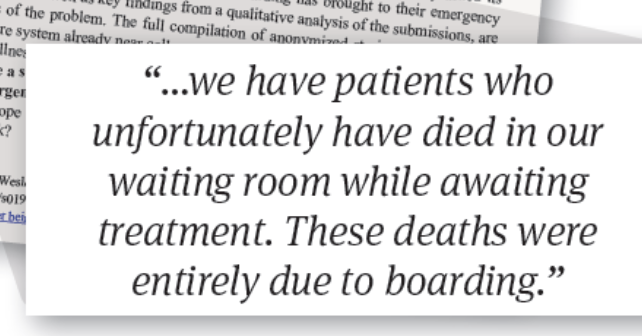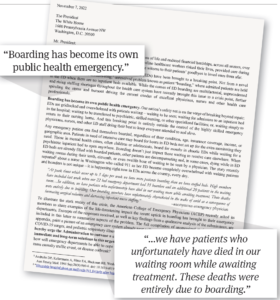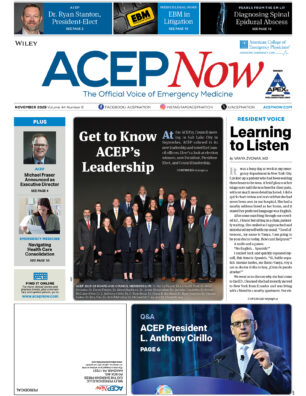
For emergency physicians, boarding and crowding isn’t a new problem. But in the past several months, you’ve made it clear things have worsened. Multiple factors converged, building a groundswell with the potential to drown emergency departments (ED) across the country. This longtime problem was now escalating rapidly. ACEP staffers heard the sense of urgency in your voices: You were once again on the front lines, only this time the front line felt more like teetering on a tightrope, dangerously close to a tipping point.
Explore This Issue
ACEP Now: Vol 41 – No 12 – December 2022The past 20 years of advocacy efforts on boarding have shown ACEP’s advocacy team that all the data in the world hasn’t moved the needle on the issue. Boarding and crowding in the ED has been a problem that is too broad, too multifactorial, too overwhelming for policymakers to address.
Your voices have gotten ACEP leadership to think, “as the collective voice for emergency physicians, how could we raise the red flag on this issue in a way that would get legislators to hear and feel your new desperation surrounding this old problem?”
It was time to let your own stories do the talking.
Story Collection
In late October, ACEP put out a call asking for members to anonymously submit their “most severe and egregious boarding stories.” The submissions immediately poured in, quickly tallying more than 100 in the first week. Your testimonials painted a grim picture of the heartbreaking reality for many EDs across the country.
As ACEP’s advocacy team read through all the submissions, certain themes emerged:
- Boarding is causing patients to experience preventable harm—even death.
- Many patients, even those who need to be admitted, are being treated in the waiting room without ever reaching a bed in the ED.
- Pediatric patients and patients with mental health emergencies are disproportionately affected.
- When physicians and other members of the care team feel they can’t provide quality care, professional burnout increases.
- Staffing shortages, especially within nursing, are making the boarding problem worse.
- Economic realities incentivize hospitals to prioritize staffing and space for more lucrative surgery patients over other admissions.
Imploring the White House
ACEP constructed a letter to the White House that outlined the severity of the situation in your own words. In the nine-page letter, ACEP called on the White House to host a summit to gather all relevant stakeholders in one place to start seeking collaborative solutions.
Prior to sending, ACEP circulated the letter among its diverse and influential network to get an additional 34 organizations to sign on, adding even more weight behind the message.
 “Sign-on letters are important because they show that a much larger constituency than just ACEP is alarmed by the recent increase in ED boarding and crowding,” explained Laura Wooster, MPH, ACEP’s senior vice president for advocacy and practice affairs. “We included patient groups in our outreach to help personalize this issue beyond the health care team—anyone needing emergency care can be impacted.”
“Sign-on letters are important because they show that a much larger constituency than just ACEP is alarmed by the recent increase in ED boarding and crowding,” explained Laura Wooster, MPH, ACEP’s senior vice president for advocacy and practice affairs. “We included patient groups in our outreach to help personalize this issue beyond the health care team—anyone needing emergency care can be impacted.”
This letter isn’t the first time the Biden Administration has heard from ACEP about the boarding issue in recent months. Back in mid-October, ACEP President Christopher Kang, MD, FACEP, represented the College during a White House roundtable discussion in preparation for the coming winter surge of COVID-19. Dr. Kang explained that ED boarding and overcrowding must not be overlooked because it impacts everything—access, wait times, delays in care, staffing shortages, burnout, and the inability to discharge patients from hospital.
He called on the administration to convene a summit on the boarding issue, planting the seed for ACEP to reiterate that specific ask in its advocacy letter.
In addition to the White House, the letter was also sent to Department of Health & Human Services (HHS) Secretary Xavier Becerra and the Department of Homeland Security Secretary Alejandro Mayorkas. How does boarding affect homeland security? The current boarding situation is a major preparedness risk—if overwhelmed EDs are struggling to address the needs of patients right now, what would happen if faced with a mass casualty event or natural disaster?
Despite competing with the noise of midterm elections, your stories were heard and prompted immediate response from federal officials. “The response to the letter has been strong,” said Ms. Wooster. “It’s clear that policymakers had no idea the situation was this bad.”
Within days of receiving the letter, HHS hosted a meeting with ACEP, the American Hospital Association, and the Association of American Medical Colleges to discuss the issue and possible next steps.
Raising Public Awareness
While the advocacy team was working on the letter, ACEP’s communications team was building a public awareness campaign to draw more attention to the problem. As soon as ACEP’s letter was sent to the White House, we also launched a new public-advocacy campaign. Centered around a sobering digital storybook housing more than 100 member stories from the front lines of the boarding crisis, the public and the media took notice.
- In addition to a press release, articles related to boarding/crowding have had mentions in more than 550 publications. As of December 1.
- On Twitter, our thread about the letter and boarding stories was our best-performing post in the past year with 464,923 impressions and 20,833 engagements, attracting attention from a wide swath of medical professionals, government officials, and journalists. As of December 1.
- Our boarding LinkedIn post was also the biggest of the past year with 64,420 impressions and 4,827 engagements. As of December 1.
- Our Facebook post has had 13,914 impressions and 2,391 engagements so far, and our Instagram stories about boarding were also widely liked and viewed in the 24 hours they were up. As of December 1.
- ACEP’s digital storybook of your boarding stories received almost 10,000 page views in its first month. As of December 1.
State-Level Advocacy
The work is happening at the state level, too. ACEP shared the letter to the White House with the National Governors Association and is working with chapters to adapt the letter to be sent to state leaders.
ACEP is continuing to collect your boarding stories in hopes of having stories from every state to bolster ongoing state advocacy efforts. Share your experience at acep.org/boarding.
Next Steps
The letter and launch of the public awareness campaign is just the beginning of ACEP’s efforts to address the boarding crisis. Dr. Kang is forming a task force on boarding to help develop concrete solutions for ACEP to bring to policymakers. The midterm elections bring a new group of members of Congress who ACEP will need to educate on the issue.
Visit acep.org/boarding to find helpful resources and the latest news on boarding advocacy efforts.
Jordan Grantham is senior content manager at ACEP.
Pages: 1 2 3 | Multi-Page





No Responses to “The Power of Your Boarding Crisis Stories”